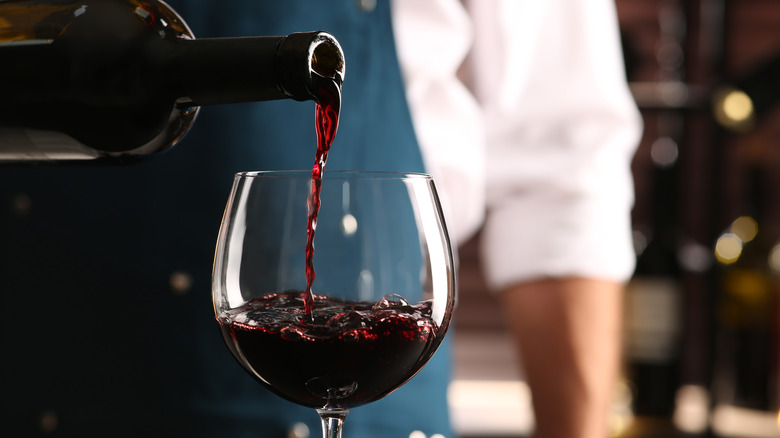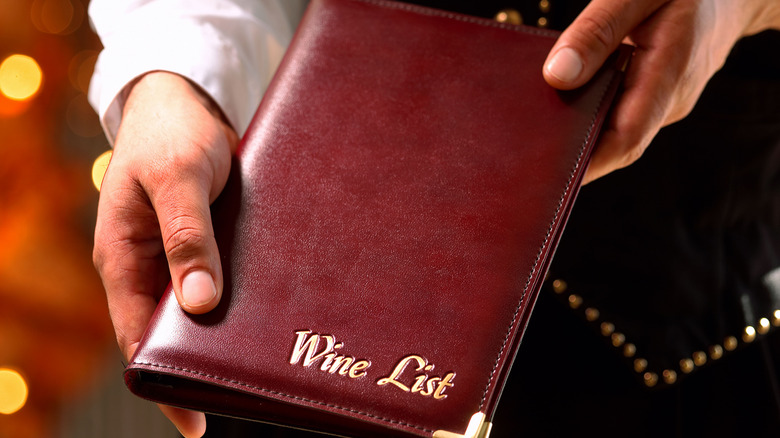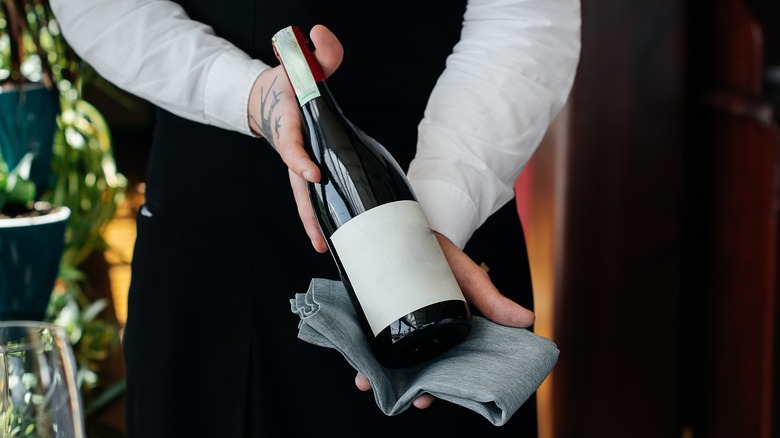An Expert Explains The Biggest Wine List Red Flag To Look Out For At A Restaurant
When you're out for a fancy meal or date night, having a glass of wine is always a fun complement to your food and adds a little bit of glamor to the evening. Most diners are happy to go with any bottle of their preferred type of wine, whether it's red or white. However, if you're concerned about how expensive wine can be at a restaurant, you might want to take a closer look at the wine list to make sure you don't fall for excessive markups.
Doreen Winkler, owner of Orange Glou in NYC — the world's first and only wine store dedicated exclusively to orange wines — provided the Daily Meal with some insight into which wines you should and shouldn't order at an eatery. When you scan the wine list, keep an eye out for options that don't match up with their price. Winkler says that "a red flag would be seeing wine that's inexpensive and easily found in a wine store or supermarket that's featured on a wine list for a lot more money."
So, you spot a generic pinot noir or Sauvignon Blanc on the menu, and the listed sum is higher than the price tag it would carry at the liquor store, it's probably not a worthwhile pick. Tasty as they may be, it's just not worth it to pay premium for the least special bottles on the list.
How to find a well-priced glass of wine in a restaurant
To get the best value on wine at a restaurant, avoiding obvious money sinkholes is easy to do, but pay close attention to the markup on more viable options, as well. Doreen Winkler advises to "consider how [the staff] price their wine lists in totality rather than focusing on markups by bottles or glass. For example, an $80 bottle on the wine list may be marked up differently than a $350 bottle."
If value is more of a concern to you than simply spending less, know that just because a wine is cheaper doesn't mean it's less marked up. Many times, cheaper bottles have higher markups, as do well-known varietals such as Malbec or Pinot Noir. This is because most diners default to popular wines without much consideration, so restaurants can get away with charging more, knowing that a markup won't be an obstacle for casual drinkers.
To choose an option with a price that's closer to what you would pay outside of a fancy restaurant, try going for a lesser-known variety, such as a Aglianico for a bold red or an Albariño for a nice, complex white. And don't be afraid to choose a bottle that's slightly higher-priced, but still within your budget — it just might be a better value than a wine that's cheaper on paper.
Why wine is so expensive at restaurants, anyway?
Although you might get sticker shock from some of the prices on wine menus, there's a method to the madness on the restaurant's side. When it comes to wine by the glass being expensive, a markup can help cover the costs of the whole bottle if the restaurant can't sell the remainder to other customers. Leftover wine can to go off, meaning it has to be thrown out, resulting in a profit loss — unless each glass is made more expensive. It's also tougher to markup food, as most people can tell when they're being overcharged for a chicken breast or burger, but wines are in a grayer area.
When you order a full bottle, the restaurant loses out less, as you'll presumably be drinking the whole thing. However, bottle costs can still be higher than what you'd find at your local liquor store because of the labor behind the order. Not only do multiple staff members get involved in choosing and serving your wine, but you get the perk of the restaurant's atmosphere and the sommelier's specialized wine knowledge. All of these factors contribute to the cost of the bottle.
Still, with Doreen Winkler's tips, you should have no problem navigating your favorite restaurant's wine menu without breaking the bank. You'll always pay a bit of a premium for your drink, but at least you can dodge the most marked-up options on the list.


